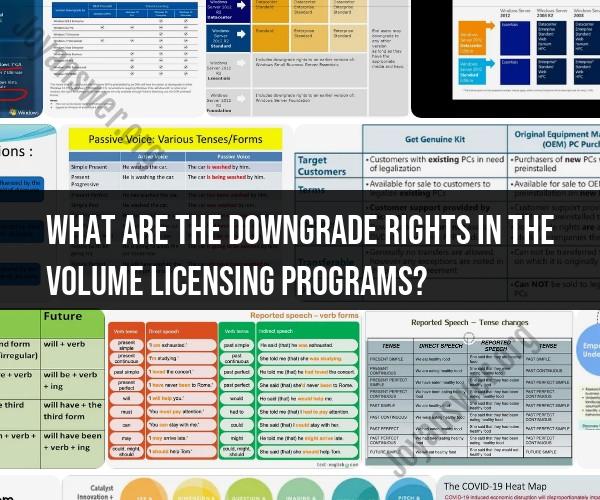What are the Downgrade rights in the volume licensing programs?
Downgrade rights in volume licensing programs, often offered by software vendors like Microsoft, provide customers with the flexibility to use earlier versions of software products instead of the latest versions they have licensed. This can be particularly useful for organizations that have specific compatibility requirements or are not yet ready to transition to the latest software releases. Here's a guide to demystifying downgrade rights in volume licensing programs:
1. Understanding Downgrade Rights:
- Downgrade rights are a feature of many volume licensing agreements, including Microsoft's. They allow customers to use a previous version of the software product, typically one or two versions older than the one they have licensed.
2. Eligibility for Downgrade Rights:
- Eligibility for downgrade rights varies depending on the specific licensing program and agreement with the software vendor. Generally, downgrade rights are available for customers who have purchased specific editions or versions of software licenses, such as Windows Server or Microsoft Office.
3. When Downgrade Rights Are Useful:
- Downgrade rights are useful in several scenarios:
- Compatibility: When certain software applications or hardware devices are only compatible with older versions of an operating system or software.
- Training and Transition: When organizations need more time to train their staff or transition their processes to the latest software version.
- Stability: When organizations prefer to use a proven and stable software version rather than adopting the latest release.
4. Licensing Documentation:
- To exercise downgrade rights, organizations need to maintain proper documentation of their original software licenses and the downgrade installation media or keys.
5. Activation and Key Management:
- Organizations should follow the activation and key management procedures specified by the software vendor when installing and using downgraded software.
6. Compatibility Considerations:
- Before downgrading, organizations should verify the compatibility of the older software version with their existing infrastructure, applications, and hardware.
7. License Limitations:
- Downgrade rights are subject to certain limitations and conditions set forth in the licensing agreement. These limitations may include restrictions on the number of downgrades or the time frame within which they can be performed.
8. Mixing Versions:
- Organizations can often run a combination of the currently licensed version and the downgraded version on the same network, as long as they comply with licensing terms.
9. Licensing Program Variations:
- Different volume licensing programs may have variations in their downgrade rights. It's essential to review the specific terms of your licensing agreement to understand the details.
10. Compliance and Audits:- Organizations should be prepared for software audits to ensure compliance with licensing agreements. Proper documentation of downgrade rights usage is crucial to pass audits successfully.
11. Transition Planning:- While downgrade rights offer flexibility, organizations should also plan for eventual upgrades to the latest software versions to benefit from new features, security updates, and support.
12. Consult with Licensing Experts:- When in doubt or facing complex licensing scenarios, consider consulting with licensing experts, legal counsel, or representatives from the software vendor to ensure compliance and make informed decisions.
Downgrade rights can be a valuable feature in volume licensing programs, enabling organizations to maintain compatibility and control over their software environment. However, it's essential to understand the specific terms and conditions of your licensing agreement and to manage downgrade rights properly to remain compliant and make the most of this flexibility.












